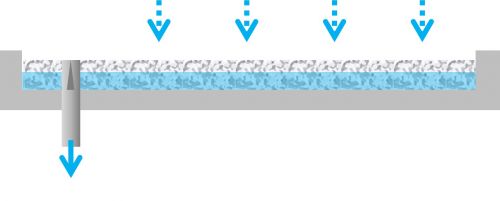Blue roofs
Blue roofs can be a very economical and low maintenance way to manage undesirable rainwater on a flat roof. For rooftop retention on moderately sloped roofs, a green roof is going to be a better choice. On steeply sloped roofs, rainwater harvesting, or diverting roof leaders to a landscape integrated LID is a more appropriate alternative.
Overview[edit]
Preceded by green roof and flow control roof drain systems, blue roof systems are an innovative green technology for flood and drought resilience and adaptation. Blue roof systems temporarily capture rainwater using the roof as storage and allow it to evaporate and/or to be used for non-potable requirements (i.e. irrigation, toilet flushing, truck washing) and ultimately offset potable water demands. Any remaining water can be gradually released into the municipal stormwater system reducing peak flow rates. Additionally, during the summer season, rainwater ponded on a flat roof can cool the interior of a building and reduce air conditioning pressures through evaporative cooling. As such, smart blue roof systems are advantageous to both the private and public sector.
Blue roof systems regulate rooftop runoff by storing and controlling the release of rainwater, thereby reducing the potential of overflow in the municipal sewer system and thus, the potential for localized flooding. Combining a blue roof system with rainwater harvesting (RWH) allows for rainwater reuse and provides additional benefits. Blue roof systems are a popular stormwater management option for flat roof buildings, particularly within the industrial, commercial and institutional (ICI) sector (which make up 23 - 30% of most urbanized areas) [1].
Blue roofs are ideal for:
- Sites without significant space at ground level for infiltration practices
- Zero-lot line projects with outdoor amenity requirements
The fundamental components of a blue roof are:
- A flat roof
- Flow control device(s)
Planning[edit]
| Advantages | Limitations |
|---|---|
|
|
Design[edit]
Water can be slowed in running from a flat roof (up to 2%) through the use of:
- drain covers (most common),
- small check dams or weirs across the roof deck, or
- modular tray systems.[3]
All roofs in Canada must be designed to support peak snow loads, providing capacity for supporting an equivalent weight of ponded water. The Ontario building code permits designers to assume that snow and water loads are not cumulative, up to a maximum depth of 150 mm (water equivalent), if precautions are taken to prevent flooding by providing a sufficient number of roof drains with overflows. It is therefore uncommon for roof water detention systems to be designed to permit more than 150 mm of water to accumulate. This also means that these systems can be retrofitted onto existing roof structures that have been designed to support conventional snow loads.[4]
The Ministry of Transportation does not currently permit blue roofs to form part of a SWM plan owing to concerns over long-term maintenance; this affects relatively few projects[5]. The concerns arise from instances where building operators have found outlet control structures blocked with leaves or other debris. Without understanding the purpose of blue roof systems and flow control drains, these devices have been removed to prevent recurrence of the blockage. A study in New York City found that a modular system of trays outperformed an outlet flow control device in stormwater management[6]. It might reasonably be expected that a modular system would present fewer opportunities for complete failure from a single action, either through clogging or breakage of a storage element.
Smart Design[edit]
Blue roofs can also be fitted with smart controls and electrically operated valves to regulate water discharging from the roof. The electrically operated valves can be tied to predictive weather algorithms to forecast incoming rain or snow events as well as extreme heat days. Based on the weather forecast, valves may be opened and closed to accommodate additional rain or snow loads. When coupled with a rainwater harvesting system, blue roofs increase rainwater storage capacity to meet non-potable water demand (i.e. toilet flushing or irrigation) without the need to oversize tanks. Rainwater harvesting tanks with smart controls are able to coordinate with blue roofs to draw water from the roof when the tank water level is low to meet demand and offset municipal potable water use. [7]
Blue roofs in the treatment train[edit]
Blue roofs can be used in combination with green roofs by employing a scaffold system to keep the vegetation rooting layer out of the ponded water. Blue roofs could also be employed in combination with a rainwater harvesting system which has daily usage demands. Coupling blue roofs with rainwater harvesting systems could offset cistern capacity requirements and supplement tank capacity deficiencies.
For Review[edit]
https://www.state.nj.us/dep/stormwater/bmp_manual/NJ_SWBMP_9.8.pdf
Providers[edit]
In our effort to make this guide as functional as possible, we have decided to include proprietary systems and links to manufacturers websites.
Inclusion of such links does not constitute endorsement by the Sustainable Technologies Evaluation Program.
Lists are ordered alphabetically; link updates are welcomed using the form below.
Flow control devices[edit]
Other[edit]
These products are designed to suspend green roof (or other) systems above a layer of free water for the detention period.
- ↑ Credit Valley Conservation. 2020. Automated Real-time IoT Smart Blue Roof Systems for the IC&I Sector for Flood and Drought Resilience and Adaptation Technical and Financial Feasibility Study. Credit Valley Conservation, Mississauga, Ontario. https://sustainabletechnologies.ca/app/uploads/2019/02/Smart-Blue-Roof-Lit-Review-Feb-2019.pdf. The appeal is the relatively low cost and simplicity of modelling and forecasting performance,
- ↑ https://www.pwdplanreview.org/manual/chapter-4/4.6-blue-roofs
- ↑ Massachusetts Clean Water Toolkit, Rooftop Detention (Blue Roofs), Retrieved 9 October 2018 from http://prj.geosyntec.com/npsmanual/rooftopdetentionblueroofs.aspx
- ↑ Richard Hammond (2017). Evaluating Green and Blue Roof Opportunities in Canadian Cities. UWSpace. http://hdl.handle.net/10012/11463
- ↑ Ontario Ministry of Transportation. (2016). Stormwater Management Requirements for Land Development Proposals. Retrieved March 7, 2018, from http://www.mto.gov.on.ca/english/publications/drainage/stormwater/section8.shtml#controls
- ↑ Bloomberg, M., & Strickland, C. H. (2012). NYC Green Infrastructure Plan: 2012 Green Infrastructure Pilot Monitoring Report. New York. Retrieved from http://www.nyc.gov/html/dep/pdf/green_infrastructure/2012_green_infrastructure_pilot_monitoring_report.pdf
- ↑ Credit Valley Conservation. 2018. Smart Blue Roof Project Literature Review Report. Credit Valley Conservation, Mississauga, Ontario.
